The Mi5s is the company’s current 5.15-inch flagship and comes hot on the heels of the Mi5, which we reviewed a few months ago. But wait! It can’t be that different to a Mi5? After all, it’s just an “s” model, not a proper next-gen launch. Well, that’s not necessarily true, and while the “s” moniker usually means a refresh for Apple, in the Xiaomi universe it does not.
The Mi5s is not just a hardware update, it’s an all new phone that doesn’t even resemble the Mi5. Whereas the Mi5 featured a curved glass back, for the Mi5s the company went with a different industrial design. Cynics may say Xiaomi made a full circle and got back to copying Apple, as the Mi5s looks a lot more like an iPhone than a Mi5.

And no, the difference is not skin deep. The Mi5s features a new Qualcomm processor, new camera and a few other bits, but it’s not radically different. It does, however, address a number of criticisms, and can be viewed as the Mi5 “done right,” although that might imply there was something wrong with the original Mi5 (hint: there wasn’t, it’s still a good product).
But here’s the problem. Apple launches “s” models a full year after the first release, while Xiaomi did it just a few months after the Mi5 launch. This means the difference in hardware between a regular iPhone and an “s” version is much bigger than the difference between a Mi5 and Mi5s.

Compared to the Mi5, the Mi5s gets a somewhat snappier SoC (SD821 vs. SD820) and a better camera, while the display, storage, and battery remain the same.
So why the hell did Xiaomi launch it to begin with? Well, we’ll get to that later. Suffice to say that we’re happy they did. Now let’s get on with our review.
Design and Build Quality
When we heard the Mi5s was in the works, we wrongly assumed it would be nothing more than a quick Mi5 refresh, using the same chassis. However, it is not.
The Mi5s features a completely different unibody chassis. It looks like a slab of alloy broken up by antennae inlays, a lot like the iPhone. The Mi5 sports a totally different look, with a glass back slapped onto a metal frame. This should also make the Mi5s a bit more resilient in “bend tests” which weren’t too kind to the Mi5.
The footprint is roughly the same, but the Mi5s is a tad bigger than the Mi5, yet it feels smaller when you pick it up. Sound weird, so what’s the deal here? Both are small and light for this product category, but the Mi5s has a more curved design, which helps it “feel” smaller. In reality though, it’s almost identical to the Mi5 in terms of size. The Mi5s also employs 2.5D curved glass on the front panel, while the Mi5 sticks to flat glass. This also helps create the illusion of a smaller, curvier device.
The Mi5 measures 144.6 x 69.2 x 7.3mm and weighs a feather-light 129g, while the Mi5s tips the scales at 145g and measures 145.6 x 70.3 x 8.3mm. In other words, the Mi5s is a millimetre thicker, but thanks to its design, it doesn’t exactly feel bigger than the Mi5. Here's how it looks next to the 5.5-inch Redmi 3 Note Pro:
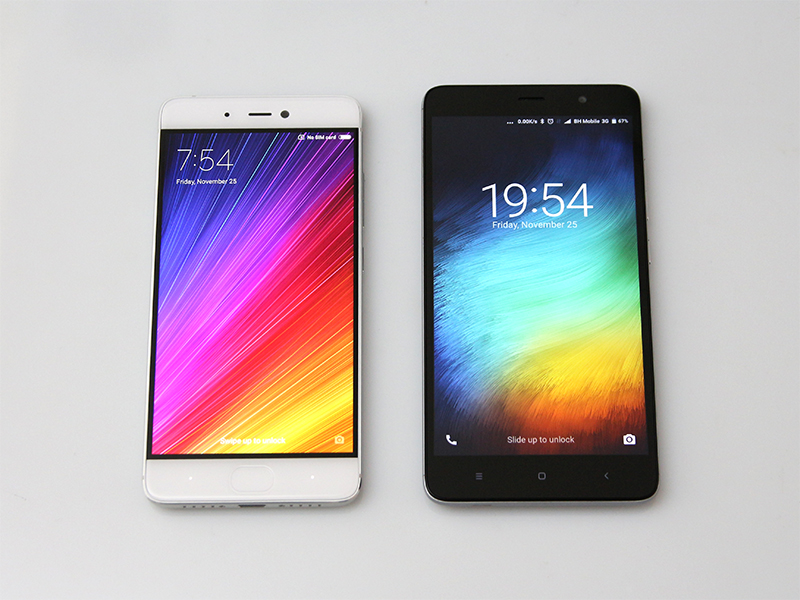
Aluminium is a lot easier to shape than glass, and it has another advantage in the aesthetics department – you get a few more colour options. Hence, the Mi5s is available in silver with a white facia, deep grey with a black front, as well as gold and rose gold for fashionistas.
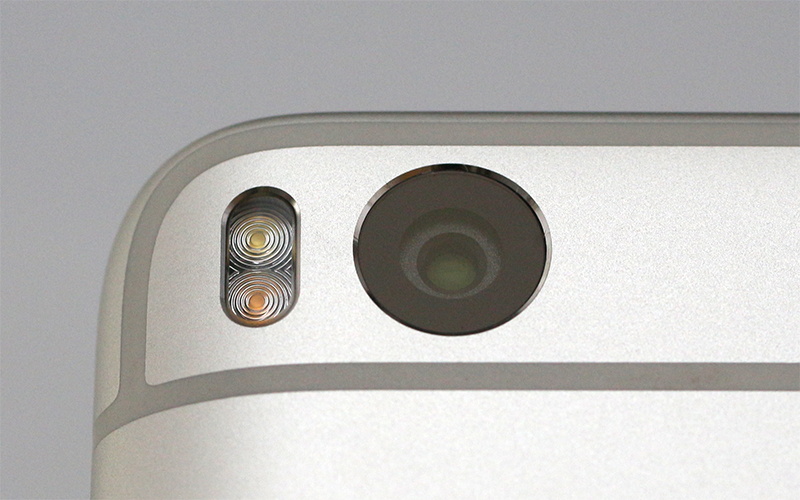
Interestingly, the camera module does not protrude out the back. It’s flush to the surface, which is not surprising when Xiaomi uses small camera sensors, but it’s kind of unusual when it integrates a massive 1/2.3” sensor. This leads us to conclude that the optics aren’t as good as what you’d get on a Galaxy S, since there’s no distinctive camera hump at the back.

The downside to using an aluminium unibody design is less obvious – it sort of guarantees you can’t end up with a very original design. That’s why the Mi5s, Google Pixel, iPhone 7, and indeed all other phones built this way tend to look similar. Perhaps too similar?
The layout and ergonomics are Xiaomi standard. The power button and volume rocker are on the right-hand side.

The dual-SIM tray is on the left.

The top houses the 3.5mm audio port and secondary microphone. The IR blaster is notably absent – it’s been a staple of Xiaomi phones for years, but for some reason, it was dropped from the Mi5s.

The USB Type-C socket is at the bottom, along with the speaker and primary microphone, and that’s about it. Nothing spectacular to see here.

Thanks to the curved front glass, the Mi5s looks a bit swankier than its glass-clad predecessor, at least when it’s facing the right way up. The front also houses the ceramic home button that doubles as a fingerprint sensor.
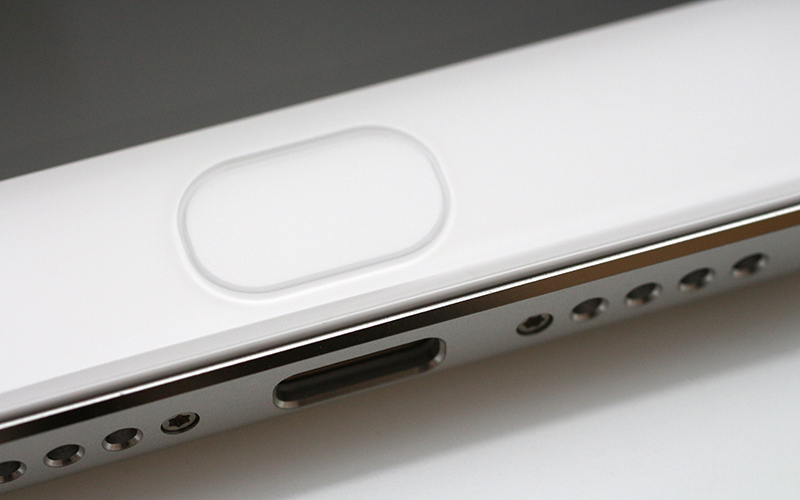
There’s not much going on at the back. It’s just a slab of alloy, with a couple of antennae cut-outs, Mi logo, and the main camera.

Overall, the Mi5s is a good looking device with a premium feel, but it’s just not very original. This doesn’t mean Xiaomi copied Apple or Google (the Pixel was in development at about the same time). It merely means that designers don’t have too much freedom with such designs. The same is true of the Mi Note 2 we reviewed a few weeks ago - it looks pretty much like every other curved display phone out there (namely the duly departed Note 7).
The designers had their hands tied. There’s simply not a lot of room for innovation or originality when you commit to a particular approach. If you’re designing an all-glass curved phone, or an aluminium unibody device, you don’t exactly start with a clean sheet of paper and you don’t get to think outside the box.
Don't get us wrong: The Mi5s is a gorgeous piece of kit, but it's not special or original.
Xiaomi Mi5s Specs and Performance
So, the Mi5s is a new phone, but it shares a lot of DNA with its predecessor. This is not a bad thing, since the Mi5 was a good device to begin with, and since its launch, Qualcomm has rolled out a new chipset.
The Snapdragon 821 is the fastest Qualcomm SoC available today, but in all honesty, it’s not a huge leap forward over the 820. Both still have the same GPU and in both cases they rely on fast UFS 2.0 storage and LPDDR4 memory.
The SD821 sports two Kryo cores clocked at 2.15GHz, backed by two additional cores at up to 1.6GHz. The original SD820 was clocked at 1.8GHz and 1.36GHz respectively, but there’s a catch. Xiaomi employed faster SD820 parts in all but the 32GB variant of the Mi5 and guess what – that variant was also clocked at 2.15GHz and 1.6GHz, just like the “new” SD821.
The Mi5s got a new camera and the flagship Pro variant with 4GB of RAM and 128GB of storage also packs Force Touch support and some ceramic trim, but that’s about it as far as new hardware goes.
- SoC: Qualcomm Snapdragon 821
- CPU: Four 64-bit Qualcomm Kyro CPU cores up to 2.15GHz
- GPU: Adreno 530
- RAM: 3GB LPDDR4 (up to 1866MHz)
- Storage: 32/64/128GB of UFS 2.0 internal storage, not expandable
- Display: 5.15-inch 1080p IPS panel
- OS: Android 7.0 with MIUI 8.x on top
- Rear camera: 12-megapixel Sony IMX378 sensor, f/2.0 aperture, 1/2.3” sensor, 1.55µm pixel size
- Front facing camera: 4-megapixel sensor, 1/3” sensor, 2um pixel size
- Battery: 3200mAh, integrated
- Dimensions: 145.6 x 70.3 x 8.3mm
- Weight: 145g
- WiFi and Bluetooth: 802.11b/g/n/ac WiFi and Bluetooth 4.1
- Sensors: ambient light, direction, accelerometer, compass, proximity, GPS, A-GPS
- Other noteworthy features: NFC
- SIM card: dual SIM (nano SIM), dual standby
- Network support:
2G: GSM 850/900/1800/1900MHz
3G: WCDMA 850/9001900/2100MHz
4G: FDD-LTE: 1800/2600MHz, TDD-LTE: B38 / B39 / B40 / B41 (Make sure to check regional compatibility prior to making a purchase)
That’s a rather nice spec, but since it’s very close to the Mi5, we won’t waste time commenting the basics. Let’s underscore the differences between the Mi5 and Mi5s – the Mi5s has a new camera sensor, Force Touch support in flagship model, marginally higher battery capacity (+200mAh), but it lacks the IR blaster found on the Mi5 (and indeed most Xiaomi phones out there, even $100 Redmis). Yes, it’s a millimetre thicker, but that’s not a big price to pay for a superior camera, 2.5D glass on the front, and a somewhat bigger battery.
Let’s check out some synthetic benchmark numbers:
As you can see, there's not much more we could wish for in Antutu. It's on a par with other SD821 devices out there.
We got some weird results in 3DMark, as the numbers were closer to SD820 devices than expected. This is probably a software problem, since other benchmarks don't suggest a drop in GPU performance.
The Basemark score is more of the same. For some reason, the results were roughly on a par with the Mi5, but still ahead of the HTC 10.
The Geekbench Multicore score is unimpressive, but that's true of all devices based on Qualcomm's latest Kryo-based Snapdragons. However, Geekbench doesn't "like" SD821 devices for some reason. This is not the first time we've seen the SD820 outperform the new SD821 in Geekbench.
Geekbench's single-thread bench was equally unkind to the SD821. As you can see, it doesn't match the slower SD820 in single-core tests, either.
While new 83x-series Snapdragons are on the way, this does not mean Snapdragon 82x devices will become obsolete overnight. Even the “old” SD820 is still a very potent processor and the SD821 is marginally better in some scenarios.
In reality, the average user will never tell the difference between a Snapdragon 821 and 820 device in everyday use. Both offer plenty of performance for anything you can throw at them, and they’re future-proof.
We’re looking forward to new 10nm parts, but frankly speaking, we can already see the mobile SoC industry maturing and moving to an Intel-like upgrade schedule. In years gone by, it was enough to squeeze a new ARM CPU and GPU architecture to an existing node and get a huge performance uplift.
This is no longer the case. Mobile SoC evolution will require a lot more effort and investment. While we’re not going to see Qualcomm and other SoC-makers implementing an approach similar to Intel’s “tick-tock” model anytime soon, it’s obvious that the industry is heading in that direction. Chipmakers will need to tap more advanced notes and architectures to ensure rapid evolution and stick to current product cycles.
This is the new normal. Get used to it!
Audio, Display and Camera Quality
We can’t say for sure, but it seems highly likely that the Mi5s features the exact same IPS LCD panel used in the original Mi5. Let’s not forget that this is a refreshed device rather than an entirely new design.
The good news? There was nothing wrong with the Mi5’s display to begin with, and it’s a pretty good panel too. It’s a 5.15-inch 1080p display rated at 600 nits brightness, which means it’s still good even by today’s standards. MIUI also has a few tricks up its sleeve. The Read Mode reduce background glare and increases colour temperature. You can also tweak colour temperature, contrast and a few other settings to get it just right.

The biggest difference, compared to the Mi5, is the use of 2.5D curved Gorilla Glass 4 on top. While curved glass does nothing for display quality, it makes the Mi5s feel substantially “smoother” than its predecessor. The Prime version with 4GB RAM and 128GB storage adds Force Touch support to the mix. The only downside of having a curved glass is that it makes the device marginally thicker. No big deal.

The side firing speaker is good, but not as loud as the one used on the Mi Note 2 or the latest iPhones. The microphone is housed next to the speaker, in the right grille. Call quality is great, and so is noise cancellation. The device also supports VoLTE for even higher fidelity.
While the display and audio system are practically transplanted from the Mi5, the camera is not. The Mi5s sports an all new camera based on Sony’s IMX378 sensor. This is the same sensor used in Google’s highly acclaimed Pixel phones, but it seems like Xiaomi pinched a few pennies on the optics.
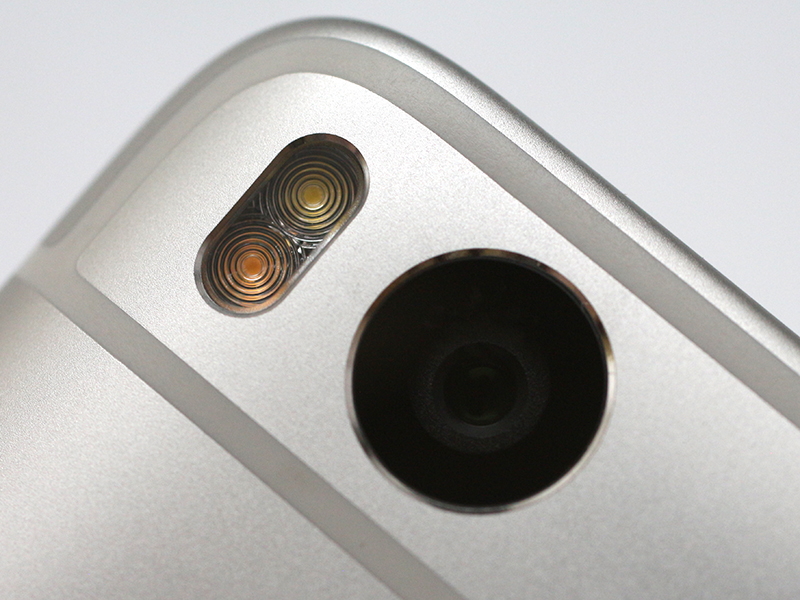
Therefore, the Mi5s won’t match the Pixel in a shootout, but that doesn’t mean the camera is no good. The Pixel set the bar very high, and the Mi5s is just a couple of steps behind.
The Mi5 features the 16-megapixel IMX298 sensor with 4-axis OIS, while the Mi5s has a 12-megapixel sensor with no OIS. What’s the catch? The IMX378 is much bigger. It’s a 1/2.3” sensor, and this size is more common to point and shoot cameras than smartphones. Therefore the pixel size is 1.55µm, and this is a substantial improvement over the 1.12µm and 1.00µm sensors used in the Mi5 and Mi Note 2.
That said, the oversized sensor would have probably produced even better results with a faster aperture, but f/2.0 is not bad, either. Let’s not forget Xiaomi doesn’t do “camera humps” and cameras on virtually all of its devices are flush to the back. There's a price to pay for this habit - you can't fit huge optics in skinny phones.

Our indoor shots prove the Mi5s has what it takes to take on most flagships today, but things could be better. Daylights shots are great, but what happens at night?

Well, you still get good results, but we were hoping for even better shots. Some night shots were under-exposed, which isn't that big of a deal. However, it seems as if Xiaomi forgot it has a great sensor in this particular device, as noise reduction is pretty aggressive. This means it's going to rob you of a lot of detail in low light, and you can see the water colour effect on our 100% crop.

Outdoor daylight shots demonstrate the abilities of the Sony sensor. We took them in horrible lighting conditions, but got good results. Here you can see the difference HDR can make in such situations.

Want more light? How about direct sunlight with some haze and clouds? The bottom image is Auto mode sans HDR, and as you can see, the sensor copes well even without HDR.

This is an HDR shot with a 100 percent crop. The sharpness is OK, as good as you can expect from a 12-megapixel device zoomed in to 100%. There are no artefacts or HDR fringing.
Overall, the Mi5s is a winner in the camera department, but it could have been even better. Still, if you want an Android phone with the best camera sensor out there, your choice is limited, and the Mi5s costs a lot less than other phones with the same IMX378 sensor. The problem? Competing devices with the identical sensor produce better photos.
The front-facing camera sticks to the same philosophy. It sports a 4-megapixel sensor 1/3” sensor, with huge 2µm pixels. This allows it to deliver good results even in low light, although 4 megapixels doesn’t sound impressive nowadays. For example, the Mi Note 2 features an 8-megapixel unit with autofocus. At the same time, the Mi5s still does well and should be good enough for any selfie lover.
OS, UI and Everyday Use
There’s not a whole lot to say about the Mi5s in the software department. The phone ships with Android 6.x and MIUI 8.x on top, and everything is where you’d expect it to be. Well, it is if you’re coming from another Xiaomi phone, but if you’re not – then nothing’s where you’d expect it to be.
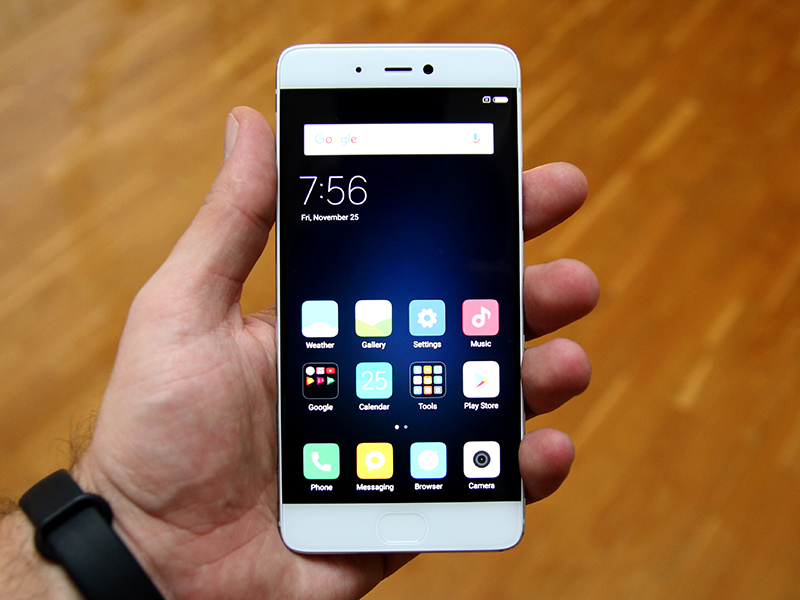
MIUI doesn’t have an app drawer, it takes a lot of its cues from iOS, and it looks and feels different to Android, or at least Android as most people perceive it. This is a double-edged sword: while we like the appearance of MIUI, and its many customisation options, users who aren’t that tech-savvy, people that not have a chance to get acquainted with MIUI, will need a fair amount of time coming to grips with the intricacies of Xiaomi’s Android fork.
This does not mean MIUI devices are harder to use or set up because they’re not. They’re just different, and because MIUI provides a high degree of control, there are more things you’ll need to address when you start using the phone.
One source of frustration revolves around notifications and MIUI’s aggressive power management. You will have to allow notifications from various apps, and make sure the ‘autostart’ permissions are ok, along with mobile data use rights and so on. Yes, it’s a bit trickier than on most Android devices out there, but only because MIUI offers a lot more options than other Android implementations.
The silver lining? MIUI allows you to take almost full control of your device, which you can fine tune for performance, endurance, or security. It’s up to you, and this is good news for power users. It’s also bad news for people who can’t be bothered. Another problem is Xiaomi’s decision to start shipping phones with a locked bootloader. This isn’t a big deal for people in China or India, but it could prove a source of frustration among users that have to import Xiaomi phones via the grey market.
Unfortunately, we can’t say anything about Xiaomi’s Force Touch implementation, as we did not get a chance to try it. Force Touch is only supported on the flagship variant which we did not get a chance to test. It’s a pity because it’s obvious that we will see more of it on upcoming devices, and chances are the next generation of Xiaomi phones, and indeed flagships from other vendors, will feature Force Touch support.

In terms of everyday use, the Mi5s is a workhorse. It’s just the right size, which is nice in a time of oversized flagships, and nobody will complain about the ergonomics.
The navigation buttons are laid out traditionally, as are all ports on the phone. One minor detail we take issue with – there’s no IR blaster. Granted, this won’t be a deal-breaker for the vast majority of consumers, but if you’re already used to having an IR blaster on your phone, you’re bound to miss it.
The home button doubles as a fingerprint reader and it’s placed at the front. But it’s not a mechanical button like the one on the Mi5, so yeah, it looks like Xiaomi is back to copying Apple again, as Cupertino made the same choice for the iPhone 7. Since the Mi5s is marginally thicker than its predecessor, due to the use of 2.5D glass and (presumably) a bigger camera module, it also features a somewhat bigger battery – 3200mAh vs. 3000mAh on the Mi5.
This isn’t a huge difference, but every milliamp counts. In the real world, we couldn’t spot much of an improvement over the Mi5. The Mi5s features slightly more powerful hardware, so if you push it hard, you’ll probably get similar or even worse battery life than on the Mi5. But if you’re careful, you’ll squeeze a bit more out of it. In real life, though, it’s a negligible difference.

We had no issues with GPS functionality, as one would expect from a device based on the latest Qualcomm hardware.
Bottom line: Xiaomi’s Mi5s is a solid all-rounder and it’s hard to point out any deficiency that will degrade user experience or pose an issue for users.
Conclusion
The Mi5s is an evolution of the Mi5, and it’s better than its predecessor in almost every respect. However, it’s not that much better, because it’s almost the same phone, updated with a new SoC and camera module. In other words, nobody who owns a Mi5 or a different Snapdragon 820 device will be interested in the Mi5s.
Although the Mi5 is hardly obsolete, the Mi5s is a welcome update, especially for people who place an emphasis on having a great camera sensor on their smartphone. The Mi5s has a spec sheet similar to the Google Pixel, yet it costs half as much, and this is its appeal. On the other hand, if you’re not a camera geek, and you just want the best value for money, the Mi5 is still worth considering, as you can pick it up for less. Gearbest, which provided us with this sample, sells the same 64GB SKU for a hair over $400, whereas the “old” Mi5 with 32GB storage comes in at under $250, which makes it a pretty good deal in our book.
We don’t mind that the Mi5s slightly thicker than the Mi5, and most users probably won’t miss the IR blaster that’s been omitted on the Mi5s. The Mi5s also feels somewhat better than the glass-clad Mi5, and the curved glass helps. The Mi5s has another thing going for it – it’s available in 5.5 inches, as the Mi5s Plus (insert another Apple pun here). The Plus variant has a bigger battery and a different, dual-camera setup, but it costs more and may be too big for some people.
Overall, the Xiaomi Mi5s is a great piece of hardware on all fronts, and its only problem is its sibling – the cheaper Mi5 is still a good choice if you want to get the best bang for your buck. However, if you want an awesome camera and snappier hardware, the Mi5s is clearly the better choice.
Xiaomi Mi5s Pros and Cons
Pros:
- Excellent camera sensor
- Performance
- Battery capacity
- Build quality
Cons:
- Unoriginal design
- The Mi5 currently offers better value for bargain hunters
- Camera software could be better optimised for IMX378 sensor






